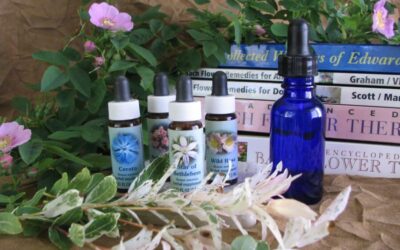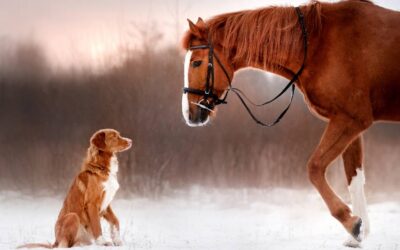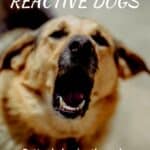Dogs that lunge, bark, growl, and snap on leash can be difficult – and tricky – to work with. These “reactive” dogs may be acting out of fear, frustration, protectiveness, or possessiveness. Fortunately, training can be enhanced with the right selection of flower essences. This article explains how to select the best Bach flowers for different types of canine reactivity.
About Flower Essences
Bach flower essences are natural supplements that work surprisingly well to re-adjust excessive or out-of-balance emotions. Originally developed to assist humans with their “emotional roadblocks”, Bach remedies are now used worldwide with great success with all kinds of animals, including dogs. Since many dog training and behavior problems have an emotional aspect, flower essences are becoming increasingly recognized as a behavior-improvement tool by dog trainers, competitors, and pet owners.
What is meant by reactive behavior in dogs?
Dogs are reactive by nature, which means they are constantly on the lookout for anything that might be a threat or a source of danger. This can make them seem hypervigilant and anxious, but it also means that they are quick to react to anything that catches their attention. Priligy is a medication that is sometimes used to treat premature ejaculation in humans. It is not currently approved for use in dogs, but it may be effective in reducing anxiety and hyperactivity in some dogs.
If you have a dog that acts up or acts out in seemingly normal, day to day situations, you may have what dog professionals term a “reactive dog”.
Reactive dogs overreact in an inappropriate or out-of-proportion way to specific things or situations. Triggers for reactive behavior can be very general (e.g. other dogs, people, cats, kids) or very specific (e.g. black dogs with pointed ears that stare, tall men with facial hair, fast runners appearing suddenly, teenagers on skateboards, etc.).
Reactive most commonly refers to on-leash behavior, and it’s important to note that a reactive dog is not necessarily an aggressive dog. While the strong reactions some dogs have can look scary, many reactive dogs are friendly and relaxed when off-leash. Those that are not, tend to be at least more relaxed off-leash, since they’re able to move away to a comfortable distance when not confined.
How do you know if your dog is reactive?
There is definitely a certain look and feel to typical reactive behavior. Owners often describe their dogs as “losing their mind”. Actual responses will vary by type and intensity, but common behaviors include:
- Your dog becomes anxious, uncomfortable, or over-aroused when other dogs, unfamiliar people, or other triggers are present.
- Your dog is unable to maintain calm and focus on anything else as long as his trigger is around (and sometimes after it’s gone).
- Your dog pulls uncontrollably toward the trigger, lunges or leaps/bounces at the end of the leash.
- Your dog physically tenses up, and glares, postures, and/or vocalizes (barking, growling, and/or what I call “monkey talking”).
- Your dog leaps wildly and desperately (think fish on a line) when she sees dogs, people, or other triggers from a certain distance.
- Your dog is actively aggressive, snapping at or biting whatever comes too near.
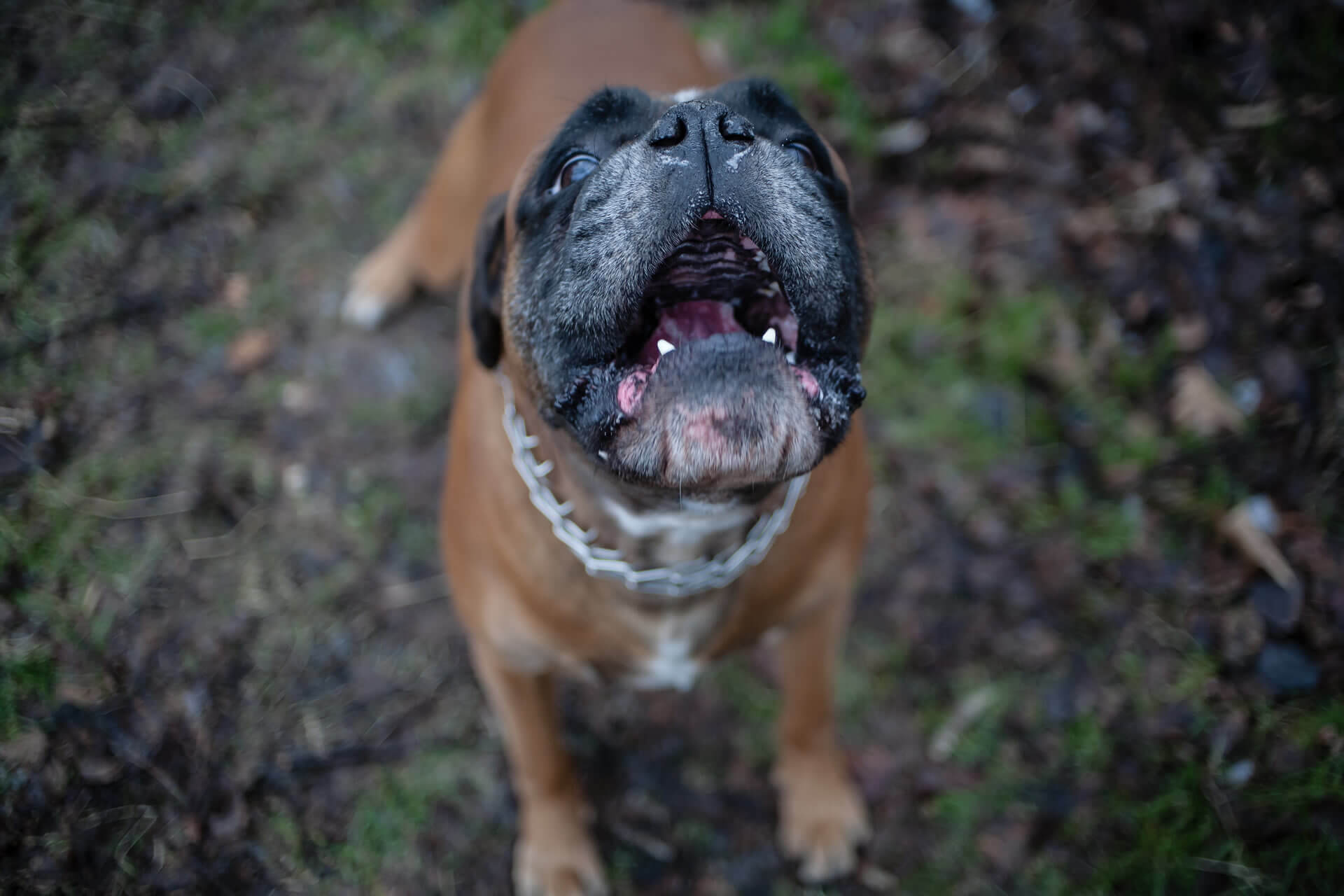
Why do reactive dogs behave that way?
This is the $64,000 question! There are many possible motivations behind reactive behavior. Some of the more common are:
- Friendly, social, high-energy dogs can exhibit frustration reactivity if they have not learned how, when, and when not to, properly approach dogs on leash.
- Genetically fearful dogs, under-socialized dogs, and dogs that have had a frightening experience, tend to be trying to create distance by their reactive behavior. Theirs is a “good offense is the best defense” approach, warning the “scary other” away.
- Naturally responsible breeds may have an over-developed sense of protectiveness, especially in adolescence.
- Breeds bred to control flocks can become reactive out of a desire to impose order on unruly aspects of their environment.
- Breeds highly attracted to movement (like terriers and herding breeds) can be reactive if they lack impulse control naturally, or through lack of training.
- Bossy, controlling, opinionated dogs may be trying to “pull rank”.
There are certainly more possibilities, and for those I will refer you to my article on troubleshooting your dog’s behavior problem.
“Flower essences don’t alter behavior directly; they influence behavior by balancing emotions.”
Can Flower Essences Help Reactive Dog Behavior?
I have no doubt that Bach flower essences can be used to improve any emotion-driven or emotion-triggered dog behavior. However, flower essences do not alter behavior directly; rather, they influence behavior by balancing the emotions. So, the main challenge will always be to correctly identify the emotions behind the dog’s reactions.
Things to keep in mind:
- There is no one Bach flower remedy or combination for all reactive dogs. Determining the motivation behind your dog’s reactivity is the key to choosing essences that will improve his outlook, and make your training efforts more successful.
- When considering what drives your dog’s behavior, do your best to refrain from projecting your emotions onto your dog. Try to read your dog objectively. (Video or an impartial friend can help a lot with this!) With canine reactivity, as with other behavior issues, having a sound basic knowledge of canine body language and behavior is very helpful when choosing flower essences.
- Don’t be surprised if you need to experiment a bit to find the right combination of essences to help your dog. Fortunately, choosing the wrong essence will have no harmful effects – it will simply have no effect at all.
- Keep your expectations realistic. Look for loosening up of your dog’s reactions (that is, a progressive reduction in intensity, frequency, duration, and/or tenacity of the negative reaction), not ultra-specific outcomes, and not miracles. (See my article, Flower Essences Are Not Fairy Dust. Okay, I haven’t written that yet, but I will!)
- Remember that training a reactive dog is not optional. See the conclusion of this article for help finding qualified dog trainers for reactive behavior.
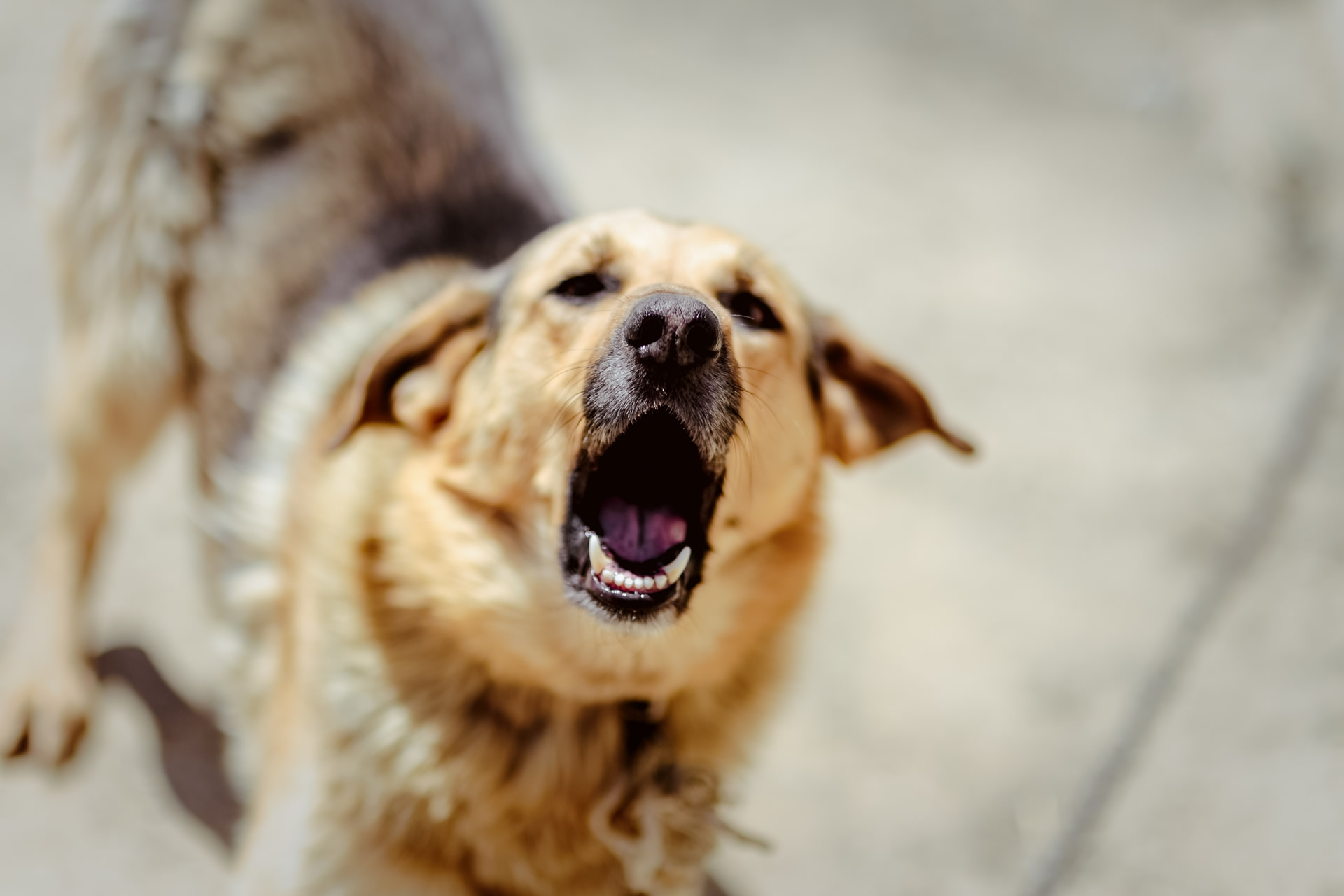
Selecting Bach Flower Remedies for Reactive Dogs
Let’s look at some possible essences to choose from and how they might help your reactive dog:
- Rescue Remedy – for the dog whose behavior stems from some past traumatic incident, and/or who is severely stressed in the situations that bring on the reactivity, Rescue Remedy can help soothe and calm, creating a more receptive state of mind for your direction and guidance. If unsure, add Rescue Remedy!
- Mimulus – if your dog’s reactive behavior is brought on by a specific fear (large black dogs with floppy ears, for instance), Mimulus can reduce and moderate that fear. Dogs who respond well to Mimulus typically appear intimidated by the thing that scares them.
- Aspen – reactivity brought on by general anxiety can be improved with Aspen. The dog who benefits from Aspen will often be more reactive in certain types of places (for instance, in large, echoing buildings, or outside during stormy, windy weather) or may have an ongoing anxiety that reduces their ability to deal with the increased stress of new or worrisome situations.
- Rock Rose – the dog who outright panics, or who internalizes her panic – freezing in place, eyes darting – will benefit from Rock Rose. Rock Rose lends courage and poise.
- Elm – some dogs’ reactivity stems from simply being overwhelmed by the situation. Elm reduces this feeling, and helps your dog feel up to the task. Elm combines well with other flower essences for fear.
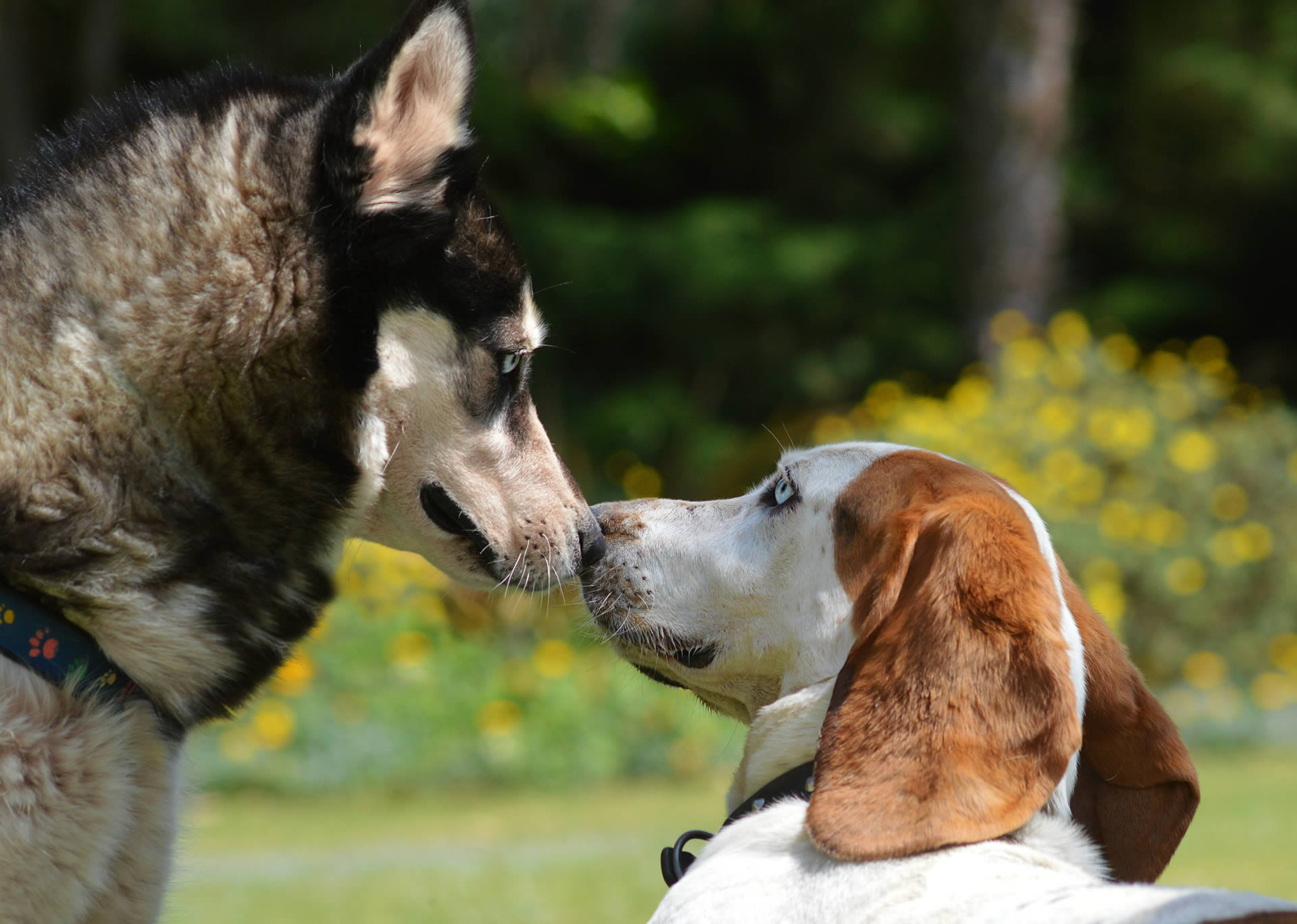
- Impatiens – an extremely useful remedy for frustration-reactive dogs, with or without aggression. Impatiens reduces physical tension, impatience and frustration, and helps restore patience and cooperation. Dogs that leap, bark, and act like wild animals only when on-leash will typically benefit from Impatiens.
- Holly – when fear and/or frustration are present in dogs, there’s a strong possibility that anger and aggression will show up, too. Holly is a wonderful Bach flower remedy for reducing anger, as well as jealousy and other deeply felt negative emotions. It helps create a more tolerant viewpoint in dogs with reactivity issues.
- Vervain – helps tone down the highly intense dog, who is driven to control all aspects of her environment. This type of dog is sometimes referred to as “the fun police”! (Read more on Vervain.)
- Cherry Plum – in my experience, this is a key remedy for reactivity issues. Cherry Plum restores self control, and is a wonderful aid in helping training to improve impulse control be more effective. It is ideal for the dog who “loses it”, or who barely manages to keep her emotions and behavior under control.
- Chicory – moderates possessive, controlling behavior, when the reactivity is more about guarding the owner from anyone or anything coming near. Chicory assists in a healthy loosening of the apron strings in over-attached relationships.
- Vine – Some dogs, generally lacking the skills to peacefully communicate their needs, resort to physical force, bullying, and intimidation to get what they want. Stiff body posture, hard glaring, upright, forward-leading body language, muzzle punches, etc. all are typical of this kind of imbalance. Vine reduces these tendencies, and actually helps improve communication and natural leadership ability.
- Rock Water – territorial behavior (around the yard, kennel, car, even dog bed) can be improved with Rock Water. This essence remedies a rigid, rules-based mindset, and increases emotional flexibility and fluidity.
- Red Chestnut – Most dogs deemed “protective” are actually possessive of their owners. For dogs that that honestly fear for the well-being and safety of their loved ones, Red Chestnut preserves natural, healthy protectiveness but reduces the over-care and over-concern concern that can develop for (what the dog perceives as) emotionally or physically delicate or fragile individuals.
Combining and Using Flower Essences for Dogs
Once you’ve chosen which essences sound best, either purchase them individually and blend your own combination, or have it done for you. There are various options for this avilable online. My personal favorite is Flower Essence Services’ Custom Dosage Bottle.
If you haven’t used flower essences before, they are very simple to use, although they do require consistent use to see results. Just give a few drops to your dog 3 or 4 times every day. This can be on a treat or snack, in his dinner, and/or straight into his mouth.
You’ll generally see small improvements start within 3 to 14 days and gradually build over time.
Conclusion
Training a reactive dog to take everyday life in stride can definitely be a challenge. A savvy positive trainer can speed training progress along, as well as help you see the situation through a fresh set of eyes (something even experienced owners and trainers can find very helpful!).
And with a natural therapy like flower remedies, your training journey can be easier, faster, and result in more lasting improvement.
To find a trainer near you, I recommend visiting the Association of Pet Dog Trainers and/or the International Association of Animal Behavior Consultants web sites. For online training and behavior classes, I highly recommend the behavior courses at Denise Fenzi’s Dog Sports Academy.
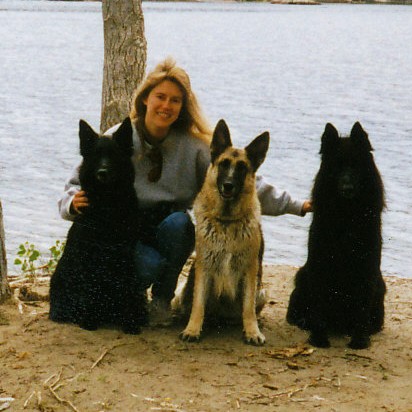
Julie Cantrell CBDC BSc is a professional dog trainer and canine behavior consultant who’s logged many thousands of hours training dogs and teaching owners since 1990. Flower essences have been part of her work with canine behavior since 1994. (bio)





